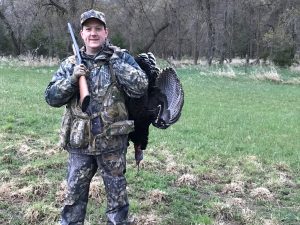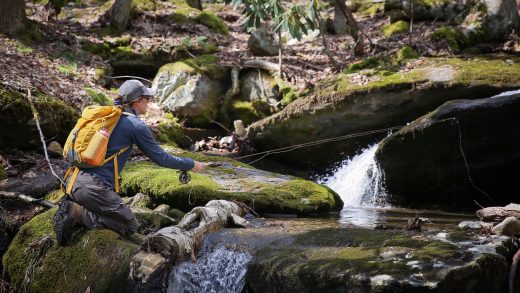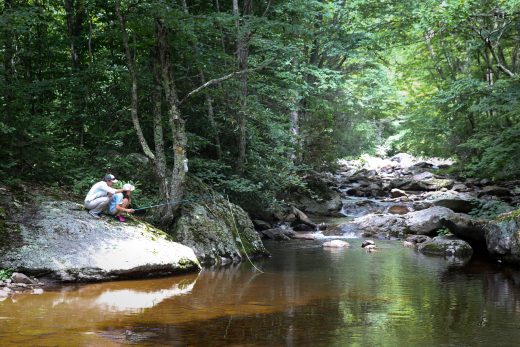By Eric Wallace

A wild turkey ‘tom’ displays in Spring – Photo by Bob Schamerhorn
For these sportsmen and women, hunting, fishing, birding, – and atlasing – go hand in hand.
Dawn is breaking over the Blue Ridge Mountains and Appalachian Mountains Joint Venture director, Todd Fearer, and his 14-year-old daughter, Libby, are sitting quietly atop a high Giles County hillside in the Jefferson National Forest. Camouflaged by a thick stand of trees, they watch the light shaft through delicate new leaves and dance across the forest floor. Already, bird songs fill the air. A wave of scarlet tanagers flitter through the canopy — lighting on a branch, males blaze like sudden blossoms.
For ten, maybe fifteen minutes, time stands still. Nudging Todd’s arm — he’s counting tanagers and jotting down notes in his outdoor journal — Libby casts Dad a knowing look.
“She recognized this was one of those rare, almost magical experiences you get in the woods,” says Todd, 44. The look said, ‘Dad, if we weren’t out here hunting, we would’ve missed this.’
Eventually, Libby hears the telltale gobble of a male turkey. He’s pretty far off, but finessing a wooden box
call, she manages to lure him up over the hill and down through the woods. Followed by a handful of hens and a young male “jake,” the big “tom” comes quickly through the undergrowth and struts into view.
Cradling her shotgun, Libby observes the gobbler fan his tail feathers and shake his bright red head and long beard. Suddenly he stiffens, his head high and alert. His keen eyes notice something out of place — a subtle turn of a head, the slight twitch of a boot. Just like that, he announces danger with a tense, “PUTT, PUTT, PUTT.” Tucking their wings against their bodies, the birds evaporate into the foliage.

Todd Fearer on a turkey hunt in 2017
Though she didn’t get a shot, for Libby, the tableau of birds and creek-side forest is a prize in and of itself.
“I teach my children the goal isn’t to kill an animal, it’s to be an active participant in the outdoors,” explains Fearer. Of his four kids, Libby is the oldest. The point, he says, is to experience nature in a way that’s different from going on a hike. “When I hunt, I’m assuming the role of ‘predator,’ which human beings have fulfilled since time immemorial.”
Do that consciously and you can feel what it’s like to directly participate in an ecosystem.
Meanwhile, remote locations and long, quiet hours of stillness create premium conditions for wildlife viewing — especially birds. Like the proverbial cherry on top, contributing data to the second Virginia Breeding Bird Atlas adds an element of volunteerism, conservation, and stewardship. Subsequently, Fearer signed up to be the principal atlaser for three survey blocks.
“While I’m always birding when I’m hunting or fishing, collecting data for the VABBA2 adds another level of purpose,” he says. “It’s rewarding to know the information I’m gathering is being used to assess the current status of breeding birds in Virginia and will inform conservation needs for a variety of species.”
Though Fearer studied avian habitat relationships for his Ph.D. and presently makes a living working to protect some of Appalachia’s most endangered birds, it was hunting and fishing that led him to ornithology.
“That’s where it all began,” he says. “Those activities introduced me to the outdoors and fostered my interest in the natural world.”
As it turns out, other bird-loving sportsmen and women have followed a similar trajectory. In far southwest Virginia, it was angling that led Blue Ridge Discovery Center program director, Lisa Benish, 52, to birding and the VABBA2.

Lisa Benish fly-fishing for cutthroat trout in the Colorado mountains
“Truth be told, I think I was born with a rod in-hand,” she says with a laugh. Growing up in Greensboro, North Carolina, some of Benish’s earliest memories involve using a cane pole and bobber to catch brim and crappie at her grandparents’ pond. “My grandfather carved duck decoys and loved to be outside hunting and fishing,” she says. “When he and Grandma got married, she didn’t want to be left behind, so she took it up and became a pretty impressive sportswoman herself.”
While neither were birders proper, their yard was studded with feeders and baths, and they kept an Audubon Society guidebook by the window. Benish says watching her grandparents get excited about birds led her to notice their presence while angling.
However, it wasn’t until her third-grade teacher introduced the term ‘naturalist’ that she realized observing nature could be considered an activity in and of itself. On a woodland tour, Benish was floored by her teacher’s knowledge of animals, trees, and fungi.
“I’d seen all of these things before, but never considered them so closely,” says Benish. “That fascinated me and definitely led me to pay closer attention when I was outside or in the woods.”
While the intrigue lingered, fishing remained the focal point of her outdoor life through childhood and beyond. Studying at East Carolina University, Benish brought friends to her grandparents’ place to camp and fish. After graduating, she moved to Galax and spent weekends fishing in the mountains near Grayson Highlands. When she had children of her own — three boys — she took them fishing too.
In fact, it wasn’t until about four years ago that Benish became formally interested in birding. Tellingly, it happened while helping her oldest son, Vincent, earn an Eagle Scout badge for fly-fishing.
“We were learning to fly-fish together and I got really into it,” she says. “It was no time before the standard rods went into storage and this was all we did.”
When the two began venturing into the mountains to fish for trout, Benish started keeping a journal. With Vincent planning to apply to colleges in Colorado, she felt compelled to write about what they did, said, and saw in the meantime.
“I realized pretty quickly we were noticing a lot of birds,” says Benish. To avoid writing the same descriptions again and again, she started learning common names. Soon enough, she was carrying an avian field guide and binoculars everywhere she went. Within a year, birding was indispensable to her fishing and outdoor experience.
BRDC executive director and birder Aaron Floyd encouraged Benish’s development, teaching her to

Lisa teaches both fishing and birding skills to students in BRDC’s summer camps
differentiate between songs and calls, and to use the information to locate birds within a wilderness environment. From there, she learned to look for distinguishing characteristics — eyes, beak, wings, tail, and so on. If she got stumped while on an adventure, she’d ask for Floyd’s help via text.
Soon enough, Benish had integrated both birding and journaling into the fishing and natural history courses she taught for the BRDC.
“I found birding to be the perfect complement to my fishing,” says Benish. “I’d take breaks from casting to look for birds, or watch for them while hiking or eating lunch… For me, it was like finding the missing piece to the puzzle.”
Most recently, Benish has developed a knack for e-Birding. So far, the highlight has been an April trip to Belize, where she observed and recorded 108 avian species. Back at home, she is working to incorporate the VABBA2 into her outdoor regimen.
For sportsmen and women like Fearer and Benish, birding has been a profoundly enriching addition to their outdoor repertoire.
Spring evenings spent fly-fishing for native rainbow trout on Mill Creek yield views of chestnut-sided warbler, eastern phoebe, red-eyed vireo and hairy woodpecker. An autumn morning in the deer-stand brings glimpses of red-shouldered and broad-winged hawks, yellow-billed cuckoo, and eastern wood-pewee.
Benish says volunteering with the VABBA2 is a bonus, as it adds a quantitative element to her outdoor experiences and enables her to contribute to avian conservation efforts. Both she and Fearer agree, it’s hard to top the combo of atlasing while hunting and fishing.
“One of the blocks I signed up to cover for the VABBA2 is in Giles County and largely owned by the Jefferson National Forest,” says Fearer. “To get a lot of surveying done, I hiked in and camped overnight. There’s a stream with native brook trout in the area, so I went fishing and wound up having fresh-caught trout for dinner. To me, that’s about as good as it gets!”
~ Eric Wallace, VABBA2 Communications

